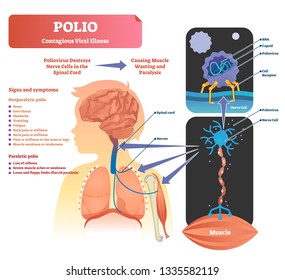
Polio also known as poliomyelitis is a highly contagious disease caused by a virus that attacks the nervous system. Children younger than 5 years old are more likely to contact the virus than any other group. According to W.H.O, one in 200 polio infections will result in permanent paralysis. However, thanks to the global polio eradication initiative in 1988. The following regions are now certified polio-free: America, Europe, western specific and Southeast Asia. The polio vaccine was developed in 1953 and made available in 1957. Since then cases of polio have dropped in United States. But polio is still persistent in Afghanistan, Pakistan, and Nigeria.
Symptoms of polio.
It is estimated that 95 to 99 percent of people who contract polio virus are asymptomatic. This is known as subclinical polio. Even without symptoms, people infected with poliovirus can still spread the virus and cause infections in others.
Non-paralytic polio: Signs and symptoms of non-paralytic polio can last from one to ten days. These signs and symptoms can be flu-like and can include; fever, sore throat, vomiting, head ache, fatigue, meningitis etc. non-paralytic polio is also known as abortive polio.
Paralytic polio: About one percent of polio cases can develop into paralytic polio. Paralytic polio can leads to paralysis in the spinal cord (spinal polio), or both (bulb spinal polio). Initial symptoms are similar to non-paralytic polio. But after week, more severe symptoms will appear. These symptoms include: loss of reflexes, severe spasms and muscle pain, loss of floppy limbs, sometimes on just one side of the body, sudden paralysis, temporal or permanent, deformed limbs, especially the hips, ankles, and feet. It is rare for full paralysis to develop. Less than 1% of all polio cases will result in permanent paralysis. In 5 to 10 percent of the paralysis cases, the virus will attack the muscles that help you breathe and cause death.
Post-polio syndrome: It is possible for polio to return even after you have recovered. This can occur after 15 to 40 years. Common symptoms of post-polio syndrome are: continuing muscle and joint weakness, muscle pain that gets worse, becoming easily exhausted or fatigued, muscles wasting, also called muscle atrophy, sleep-related breathing problems, low tolerance of cold temperature, new onset of weakness in previously uninvolved muscles, depression, trouble with concentration and memory.
How does polio virus affect someone?
As a highly contagious virus, polio transmits through contact with infected feces. Object like toys that have come near infected feces can transmit the virus. Sometimes it can transmit through a sneeze or a cough, as the virus lives in the throat and intestines. This is less common.
People living in areas with limited access to the running water or flush toilets often contact polio from drinking water contaminated with infected human waste. According to the mayo clinic, the virus is so contagious such that anyone living with someone who has the virus can catch it too. Also, pregnant women, people with weak immune systems like those who are HIV positive and young children are more susceptible to the poliovirus.
How to diagnose polio. A doctor will diagnose polio by carefully looking at the symptoms. He or she will perform a physical examination and look for impaired reflexes, back and neck stiffness, or difficulty lifting up the head while lying flat. Lab will also test a sample of the individual’s throat, stool, or cerebrospinal fluid of the poliovirus.
Treatment of polio. Doctors can only treat the symptoms while the infection runs its course. But since there is no cure, the best way to treat polio is to prevent it with vaccinations. The most common supportive treatments include: bed rest, pain killers, antispasmodic drugs to relax muscles, antibiotics for urinary tract infections, portable ventilators to help breathing, physical therapy or collective braces to help with walking, heating pads or warm towels to ease muscles aches an spasms, physical therapy to treat pain in the affected muscles, physical therapy to address breathing and pulmonary problems, pulmonary rehabilitation to increase lung endurance. In advanced cases of leg weakness, a person may need a wheelchair or other mobility devices.
Polio prevention: The best way to prevent polio is to get vaccination. Children should get polio shots according to vaccination schedule presented by the centre for disease control and prevention in the following manner.
Age Dose
2 months one dose
4 months one dose
6 to 8 months one dose
4 to 6 years booster dose.